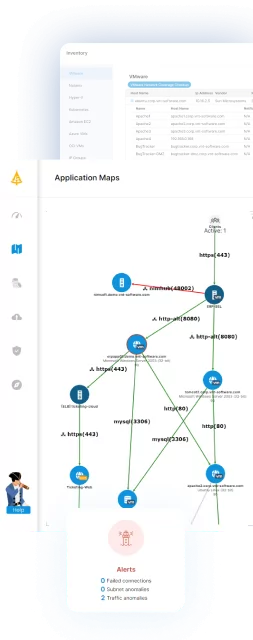What Is Virima?
Virima is an IT management platform that combines IT asset management (ITAM), IT service management (ITSM), and IT operations management (ITOM) into a unified solution. It helps organizations gain visibility and control over their technology environments through automated discovery, configuration management, service mapping, and deep integration with ITSM tools.
Virima is intended to address common challenges in IT environments—such as incomplete or inaccurate configuration data—by offering automated tools for asset discovery and dependency mapping. The platform supports both agentless and agent-based discovery across on-premise and multi-cloud infrastructure, providing a real-time view of IT assets and services.
By simplifying asset inventory, service relationships, and incident data into a centralized, visual interface, Virima helps IT teams reduce manual effort, improve service reliability, and accelerate response times. It also provides fast time-to-value and return on investment, making it a practical solution for IT management.
Key Features of Virima
Virima offers a range of features designed to simplify and unify IT asset, service, and operations management. Key capabilities include:
- Agentless and agent-based discovery: Automatically detects physical and virtual assets across hybrid environments. Agentless IP-based scanning is complemented by optional agents for continuous monitoring and off-network visibility.
- Configuration management database (CMDB): ITIL SACM-compliant CMDB enhanced with automation and deep integration capabilities. It synchronizes with external data sources and ITSM platforms to maintain an accurate configuration baseline.
- Service and dependency mapping: Identifies application and infrastructure dependencies automatically. Enables impact analysis, migration planning, and incident resolution with visually rich relationship maps.
- Virima Visual Impact Display (ViVID™): Provides an interactive visualization of service maps overlaid with live ITSM data like incidents, changes, alerts, and vulnerabilities. Improves situational awareness for IT operations and security teams.
- IT asset management (ITAM): Supports lifecycle management of hardware and software assets. Delivers insights into inventory, licensing, compliance, and financial reporting.
- ITSM integrations: Offers codeless integrations with platforms like ServiceNow, Ivanti, and Jira Service Management. Enables bi-directional data sync to maintain alignment between IT operations and service management processes.
- IT operations management (ITOM): Combines discovery, CMDB, and ViVID to deliver integrated ITOM capabilities. Supports SACM and enables unified visibility across infrastructure and services.
- Managed service provider (MSP) support: Provides tools for MSPs to deliver Virima’s capabilities to their clients, including multi-tenant support, secure access, and service offerings such as CMDB-as-a-Service.
Virima Pricing Bundles
Virima offers three primary pricing bundles designed to meet a range of IT management needs: Discovery, ITAM, and MSP. These bundles can be purchased individually or combined to create a custom solution. Annual subscriptions start at $15,000 USD.
Table of Contents
ToggleDiscovery
The Discovery bundle focuses on visibility into IT environments through automated discovery and mapping tools. It includes an ITIL-compliant CMDB, agentless and agent-based discovery, and support for hybrid environments including Windows, Mac, and Linux. Key capabilities include service mapping, cloud discovery, application dependency mapping, and network topology visualization. The bundle also supports business rule/runbook automation, ITSM integrations, API integration, and reporting via dashboards.
ITAM (IT Asset Management)
The ITAM bundle provides native integration with Virima Discovery and CMDB to support lifecycle management of IT assets. Features include hardware and software asset management, software usage metering, license and certificate management, contract and vendor management, and IT finance and procurement tracking. The bundle is also equipped with automation capabilities, API integrations, and reporting tools.
MSP (Managed Service Provider)
Designed for service providers, the MSP bundle includes a dedicated multi-tenant environment and access to all Discovery and ITAM features. It adds MSP-specific functionality like client-specific self-service portals, a single login/admin portal, CMDB-as-a-Service, and more flexible subscription and billing options. It supports ITSM integrations, runbook automation, visual impact display (ViVID), and private hosting options.
Virima Limitations
Virima provides capabilities across IT asset, service, and operations management, but there are some limitations that users should consider. These limitations were reported by users on Capterra:
- Clunky user interface: Some UI elements are hard to navigate. Column widths can’t be customized, and overall design could use refinement.
- Non-WYSIWYG forms: Form editing isn’t visual, requiring manual adjustments to get content in the right place.
- Slow and variable scan performance: Discovery scans can be slow and inconsistent in duration, particularly in complex setups.
- Limited UI-based administration: Backend and database tasks can’t be performed directly through the application interface.
- Self-contained system design: Features like sending alerts or emails to external addresses require extra setup and aren’t enabled by default.
- Integration issues with non-windows systems: Some configuration challenges may arise with non-Windows environments, though support is generally responsive.
- No support for legacy Intermec scanners: Due to vendor restrictions, legacy Intermec devices can’t be monitored.
- Interface not optimized for all devices: While mobile access is available, the browser-based interface takes time to get used to on smaller screens.
- Rapid feature releases can introduce instability: Frequent updates bring new functionality but may also cause occasional instability.
- Smaller market presence: Virima has a relatively low profile in the IT management space, which may be a concern for some organizations.
Notable Virima Alternatives
1. Faddom
Faddom is an agentless application dependency mapping platform designed to provide complete, real-time visibility into on-premise, cloud hybrid environments. It helps IT teams automatically discover infrastructure and application dependencies, making it easier to plan changes, optimize resources, and improve security posture.
Key features include:
- Agentless, real-time discovery: Continuously maps infrastructure and applications across hybrid environments without installing agents or requiring credentials.
- Application dependency mapping: Automatically detects and visualizes relationships between servers and applications to support change management, optimization, application migration planning, and risk analysis.
- Fast deployment: Fully operational in under 60 minutes with no complex configurations or long setup times.
- Security and compliance visibility: Identifies shadow IT, east-west traffic, and subnet-level dependencies to improve governance and support micro-segmentation planning.
- ITSM integrations: Integrates with tools like ServiceNow to provide shared visibility between infrastructure and service management teams.
- Affordable and scalable licensing: Transparent pricing per server with a single license that covers all use cases, making it ideal for growing environments.
2. ManageEngine ServiceDesk Plus
ManageEngine ServiceDesk Plus is a unified IT and enterprise service management platform that combines ITSM, IT asset management, and configuration management. It is available as a cloud or on-premises deployment and provides native integrations with other ManageEngine products, enabling department-specific service desk instances.
Key features include:
- AI-powered automation: Built-in AI capabilities like virtual agents, predictive ticket triage, and response generation using technologies such as ChatGPT and Microsoft Copilot.
- ITIL-certified practices: Supports 14 ITIL-certified practices, helping organizations align service management processes with industry best standards.
- Low-code customization: Offers tools for building and deploying custom forms, workflows, modules, and reports with minimal coding effort.
- Deployment options: Available as cloud-based and on-premises, with support for migration between models.
- Enterprise service management: Extends ITSM capabilities to departments like HR, facilities, and finance with data and workflow separation.
Source:
3. ServiceNow CMDB
ServiceNow Configuration Management Database (CMDB) is a centralized platform for managing and maintaining accurate configuration item (CI) data across the enterprise. Acting as a unified system of record, it enables organizations to connect disparate systems, manage digital lifecycles, and automate decision-making.
Key features include:
- CMDB workspace: A centralized interface to explore, validate, and manage CI data. It supports activity tracking and insight generation to ensure data accuracy.
- Service graph connectors: Pre-built, certified integrations that simplify the import and normalization of external data from various IT systems.
- Data acquisition tools: Tools to collect and curate configuration data from multiple sources.
- Visualization and reporting: Offers interactive maps and reports that illustrate technical and business relationships between CIs, supporting impact analysis and operational planning.
- Automated context refresh: Enables real-time updates and context-aware decision-making by continuously refreshing data and providing impact assessments.
Source: ServiceNow
4. Device42
Device42 is an IT asset management and discovery platform to provide visibility into physical, virtual, and cloud infrastructure. It offers both agentless and agent-based auto-discovery tools that populate an audit-ready inventory. It supports custom asset types, detailed relationship mapping, software inventory, and contract lifecycle tracking.
Key features include:
- Auto-discovery: Supports scheduled and continuous discovery of assets across on-prem, virtual, and cloud environments. Works with multiple protocols (SNMP, WMI, SSH, IPMI) and supports virtualization platforms and cloud providers.
- Hardware and software inventory: Tracks servers, switches, VMs, and non-IP assets. Software discovery identifies deployed applications, tracks licenses and usage, flags prohibited software, and monitors compliance.
- Asset relationship mapping: Visual impact charts show dependencies between hosts, services, and devices. Helps assess downstream effects of failures or changes and improves root cause analysis.
- QR codes and mobile support: Enables smartphone-based inventory management. Users can print and scan QR codes, manage asset tags, and view inventory data from mobile devices.
- Warranty and lifecycle management: Automatically retrieves and updates warranty data from vendors like Dell, IBM, and Lenovo. Tracks asset contracts, expiration dates, and supports audit-friendly reporting.
Source: Device42
5. BMC Helix CMDB
BMC Helix CMDB is a scalable, service-aware configuration management database to centralize and normalize IT infrastructure data. Built on a standards-based data model, it provides a view of configuration items (CIs) and their relationships to applications, business services, and users.
Key features include:
- Adaptable data model: The industry-standard data schema can be extended or customized to meet organizational requirements.
- Data quality and integrity engines: Built-in rule-based engines ensure normalized and deduplicated data by managing data source prioritization and reconciliation.
- Service-centric relationship mapping: Captures physical and logical dependencies between IT components and business services for impact analysis and change planning.
- Visual CMDB explorer: Offers data visualization tools for exploring CIs and understanding service impacts through context-aware views.
- Enterprise data consolidation: Aggregates data from multiple sources into a single reference system.
Source: BMC
Conclusion
Choosing the right IT management platform depends on an organization’s infrastructure complexity, compliance requirements, and integration needs. The most effective solutions offer continuous visibility, minimize manual effort, and support key functions such as change management, incident response, and security audits.
Platforms that deliver accurate discovery, seamless ITSM integration, and real-time dependency mapping without relying on agents stand out by offering faster implementation, lower overhead, and greater clarity in dynamic IT environments. This lightweight and scalable approach enables organizations to enhance service reliability, mitigate risks, and maintain a comprehensive understanding of their entire infrastructure.






